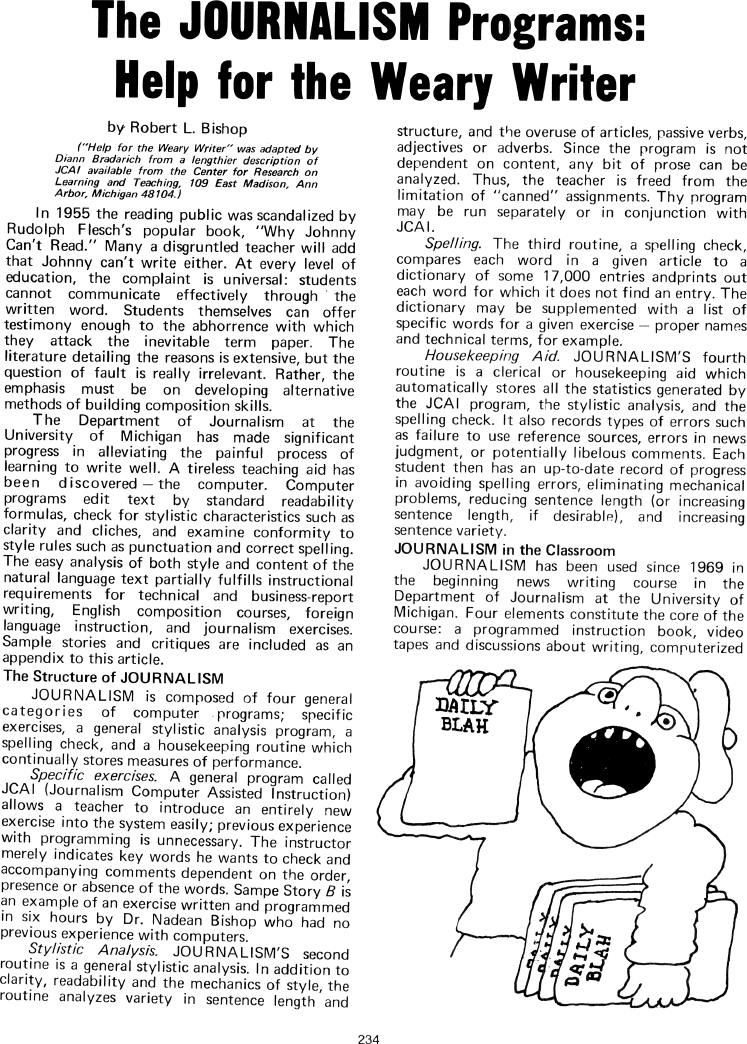The Best of Creative Computing Volume 1 (published 1976)
The JOURNALISM Programs: Help for the Weary Writer (computer programs that teach writing, Journalism Computer Assisted Instruction, readability formulas, stylistic analysis)

The JOURNALISM Programs:
Help for the Weary Writer
by Robert L. Bishop
("Help for the Weary Writer" was adapted by Diann Bradarich from a lengthier
description of JCAI available from the Center for Research on Learning and
Teaching, 109 East Madison, Ann Arbor, Michigan 48104.)
In 1955 the reading public was scandalized by Rudolph Flesch's popular book, Why
Johnny Can't Read." Many a disgruntled teacher will add that Johnny can't write
either. At every level of
education, the complaint is universal: students cannot communicate effectively
through the written word. Students themselves can offer
testimony enough to the abhorrence with which they attack the inevitable term
paper. The literature detailing the reasons is extensive, but the question of
fault is really irrelevant. Rather, the
emphasis must be on developing alternative methods of building composition
skills.
The Department of Journalism at the University of Michigan has made significant
progress in alleviating the painful process of learning to write well. A
tireless teaching aid has been discovered - the computer. Computer programs edit
text by standard readability
formulas, check for stylistic characteristics such as clarity and cliches, and
examine conformity to style rules such as punctuation and correct spelling. The
easy analysis of both style and content of the natural language text partially
fulfills instructional requirements for technical and business-report writing,
English composition courses, foreign language instruction, and journalism
exercises. Sample stories and critiques are included as an appendix to this
article.
The Structure of JOURNALISM
JOURNALISM is composed of four general categories of computer programs; specific
exercises, a general stylistic analysis program, a
spelling check, and a housekeeping routine which continually stores measures of
performance.
Specific exercises. A general program called JCAI (Journalism Computer Assisted
Instruction) allows a teacher to introduce an entirely new exercise into the
system easily; previous experience
with programming is unnecessary. The instructor merely indicates key words he
wants to check and accompanying comments dependent on the order, presence or
absence of the words. ****Sample Story B is an example of an exercise written
and programmed in six hours by Dr. Nadean Bishop who had no
previous experience with computers.
Stylistic Analysis. JOURNALISM'S second routine is a general stylistic analysis.
In addition to clarity, readability and the mechanics of style, the routine
analyzes variety in sentence length and structure, and the overuse of articles,
passive verbs, adjectives or adverbs. Since the program is not dependent on
content, any bit of prose can be analyzed. Thus, the teacher is freed from the
limitation of "canned" assignments. The program may be run separately or in
conjunction with JCAI.
Spelling. The third routine, a spelling check, compares each word in a given
article to a dictionary of some 17,000 entries and prints out each word for
which it does not find an entry. The dictionary may be supplemented with a list
of specific words for a given exercise - proper names and technical terms, for
example.
Housekeeping Aid. JOURNALlSM'S fourth routine is a clerical or housekeeping aid
which automatically stores all the statistics generated by the JCAI program, the
stylistic analysis, and the spelling check. It also records types of errors such
as failure to use reference sources, errors in news judgment, or potentially
libelous comments. Each student then has an up-to-date record of progress in
avoiding spelling errors, eliminating mechanical problems, reducing sentence
length (or increasing sentence length, if desirable), and increasing sentence
variety.
JOURNALISM in the Classroom
JOURNALISM has been used since 1969 in the beginning news writing course in the
Department of Journalism at the University of
Michigan. Four elements constitute the core of the course: a programmed
instruction book, video tapes and discussions about writing, computerized
DAILY
BLAH


